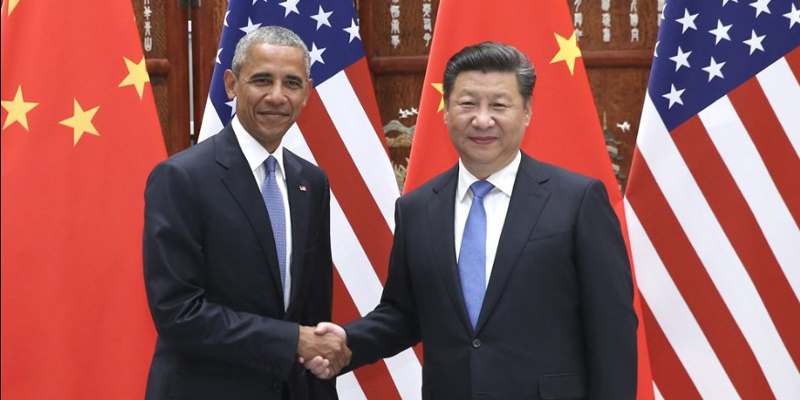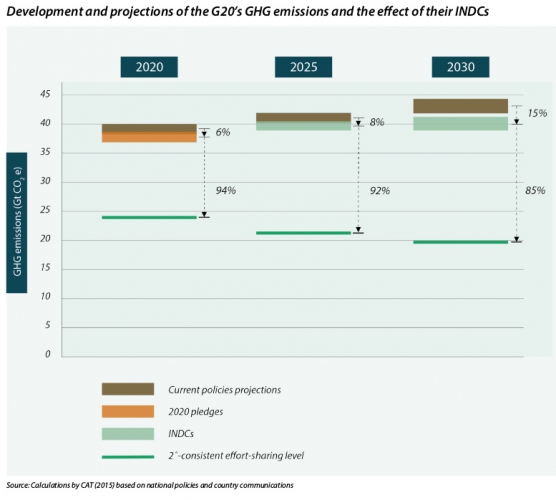Deciphering the US-China bilateral climate change outcomes

These bilateral negotiations should be widely welcomed. They proved to be an important stage setter for the Paris Agreement at COP21 in Paris which set in place for the first time a true international framework for reducing greenhouse gas emissions and dealing with climate change.
Read the U.S.-China Climate Change Outcomes (Whitehouse.gov) in full.
United States and China ratify Paris Agreement
The formal occasion in Hangzhou China was used to lodge instruments of ratification of the Paris Agreement with UN Secretary General Ban Ki-Moon, and call for all other UNFCCC signatory countries to ratify the agreement this year. (Second Outcome)
Read more on this by me: China and the United States Ratify Paris Agreement on climate
Phaseout HFCs refrigerant gases under Montreal Protocol
The third outcome focussed on negotiating an ambituous amendment restricting HFCs as part of the Montreal Protocol. This treaty was established to slow down and reverse the destruction of the ozone layer in the atmosphere and has already had a noticeable impact. But some of the replacement refrigerant gases such as HFCs are also strong greenhouse gases. Improving efficiency standards and researching alternatives is important to transform the air conditioning industry use of refrigerants.
Why is this important? Because research shows that phasing out HFCs could save 0.5C of warming by the end of the century. (Xu et al (2013) - The role of HFCs in mitigating 21st century climate change (PDF)). It is clear that Phasing Down HFCs Under Montreal Protocol Can Cut Climate Pollution Twice Over (IGSD)
Capping aviation emissions
The fourth outcome dealt with aviation emissions. Emissions from aviation and shipping were not specifically mentioned in the Paris Agreement, despite their size as the 7th largest source of total global emissions and projected to rapidly increase. For the moment the International Maritime Organisation (IMO) and International Civil Aviation Organisation (ICAO) have the mandate for addressing emissions in this area, although Meinhard Doelle, a Professor in the Schulich School of Law at Dalhousie University argues that control of this sector's emissions could be brought under the UN climate regime if their efforts are seen as insufficient.
The United States EPA in July 2016 declared that jet engine exhaust endangers public health by contributing to climate change, announcing that it will work to develop regulations that will cut carbon emissions from commercial aircraft.
The International Civil Aviation Organisation (ICAO) Assembly, to meet from 27 September to 7 October 2016, has before it a plan for a global market-based measure (MBM) for international aviation emissions.
This amounts to an offsets program for civil aviation, a small step in the right direction but doesn't really reduce emissions. The proposal being put forward aims to cap the carbon pollution of all international flights at 2020 levels, but be voluntary between 2021 and 2026 and then mandatory from 2027 for the world's largest emitters. Airlines that exceeded their cap would need to buy carbon credits from designated environmental projects. China and the US support the first, voluntary, phase. Mexico, Canada and Indonesia have said they would join, and now the European Union have agreed to join the aviation emissions pact (This includes 16 surrounding countries including Turkey, Ukraine and Georgia).
Read more on the NGO campaign dedicated to reducing aviation flight emissions at FlightPath1.5
Building co-operative partnerships and taking ambituous domestic action
The fifth outcome celebrated the US-China partnerships in Climate Change Working Group (CCWG) and U.S.-China Clean Energy Research Center (CERC), and the U.S.-China Climate-Smart/Low-Carbon Cities Summits in 2015, 2016 and the upcoming summit in Boston in 2017.
The sixth outcome reiterated and committed both countries "to continue taking ambitious domestic action to further promote the transition towards green, low-carbon and climate-resilient economies both domestically and internationally."
US efforts for greenhouse gas reduction
The seventh outcome dealt with US domestic climate policy and greenhouse gas reduction including:
- a five-year extension of production and investment tax credits for wind and solar energy will deploy roughly 100GW of renewable energy over the next five years
- a pause in new coal leasing on federal lands, while undertaking a comprehensive review of the federal coal program
- New vehicle efficiency standards for heavy-duty vehicles, which will reduce more than 1 billion tons of carbon pollution over the life of the program
- 20 additional efficiency standards for appliances and equipment by the end of the year, which will contribute to achieving its goal of cutting 3 billion metric tons of carbon pollution from such standards.
- measures to reduce domestic HFCs and methane from the oil and gas and landfill sectors
China efforts for greenhouse gas reduction
The eighth outcome dealt with China domestic climate policy and greenhouse gas reduction, detailing actions during the 13th Five-Year Period (2016-2020):
- Decrease carbon dioxide per unit of GDP and energy consumption per unit of GDP by 18% and 15% respectively
- increase the share of non-fossil fuels in primary energy consumption to 15%
- increase the forest stock volume by 1.4 billion cubic meters
- increase efforts to increase energy efficiency in industries, transportation and buildings,
- promote green power dispatch to accelerate the development of renewable energy
- start in 2017 its national emission trading system
- phase down the production and consumption of HFCs
- promote low-carbon development of transportation by developing standard modern transportation equipment and energy-efficient, environmentally-friendly means of transport.
Climate Finance and clean energy investment
The ninth and final outcome dealt with climate finance and investment, including limiting export finance for coal-fired power stations.
It described how the United States worked with other OECD member countries in 2015 to adopt new OECD guidelines to limit export finance for overseas coal-fired power plants.
Unfortunately Japan, Korea and Australia were able to insert exceptions in these guidelines to allow for 'high-efficiency' coal power stations to still be financed and built. Australia did this to ensure a market for coal. Japan wanted the exceptions has it has developed these 'high efficiency' coal technology processes. And Korea is big in financing coal power. PhD student Marc Hudson had an illuminating background paper on this on OECD coal subsidies decision, or read Luke Kemp at The Conversation on how the OECD agreement deals another blow to coal worldwide.
On climate finance, the United States remains committed to the goal now enshrined in the Paris Agreement of jointly mobilizing 100 billion US dollars per year by 2020 to address the needs of developing countries in the context of meaningful mitigation and adaptation action.
But really this amount is just a drop in the bucket needed to support adaptation and mitigation action across the many developing nations. Climate economics researchers Alex Bowen, Emanuele Campiglio & Sara Herreras Martinez in a 2015 study published in Climate Policy called An ‘equal effort’ approach to assessing the North–South climate finance gap (abstract), estimated that an equitable North–South annual financial transfer of around US$400 billion (4 models) to $2 trillion (2 models) may be required by 2050. That $100 billion commitment looks rather low in comparison and should under the principles of fairness and equity be quadrupled as part of the climate debt by industrialised countries.
China undertook in this outcome to strictly control public investment flowing into projects with high pollution and carbon emissions both domestically and internationally.
Increased climate action by G20 nations needed to close the gap
The bilateral outcome between the US and China was completed as a precursor to the G20 nations heads of state forum. No doubt this bilateral will spurr major discussion at the G20 on climate action and the Paris Agreement, as it should do.
Research by Climate Transparency in their Report for China Presidency 2016 shows an enormous Emission reductions gap between G20 nation plans (INDCs) and the Paris Agreement temperature targets. The INDCs only cover 15 percent of the reduction needed for moving to a 2 degrees C decarbonisation trajectory. To keep within a 2 degrees C trajectory, the G20 nations need to increase 2030 climate action at least six fold more than the plans that are currently registered with the UNFCCC.
The Climate Transparency report highlights
- Coal is the main issue with the carbon intensity of the G20’s energy sector
- G20 member states’ pledged climate action is still far from where it needs to be to meet the Paris Agreement’s temperature goals. G20 energy-related emissions need to be reduced six times what has been pledged so far.
- While renewable energy has increased by 18 per cent since 2008, G20 annual country investment in power sector transition by 2035 will need to roughly double to be in line with a 2 degrees C trajectory.
- Fossil fuel subsidies need to be phased out. The G20 has repeatedly committed to removing these subsidies since 2009.
- Energy-related emissions per capita, currently averaging across the G20 at 5.7tC02e/y per person, has decreased slightly, but needs to drop right back to 1-3tC02e/y per person by 2050 to keep on a below 2 degrees C warming trajectory.
- G20 economies’ energy intensity and carbon intensity are both decreasing, but not enough to compensate for the increase in economic activity.
The report recommendations to the G20 nations were for:
- countries to commit to base infrastructure investment consistent with keeping temperature increase "well below 2°C, pursuing efforts to keep it below 1.5°C";
- ensure their repeated declaration to end fossil fuels subsidies becomes a reality to ensure those fuels reflect true environmental costs;
- and introduce a price on carbon, whether through a carbon tax, levy or emissions trading.
Get Involved
If you'd like to help with maintaining or developing the website, contact us.
Publish
Publish your stories and upcoming events on Indybay.



